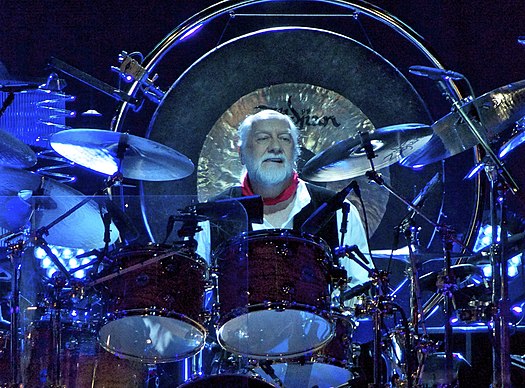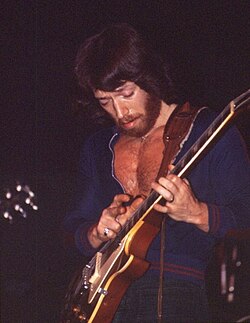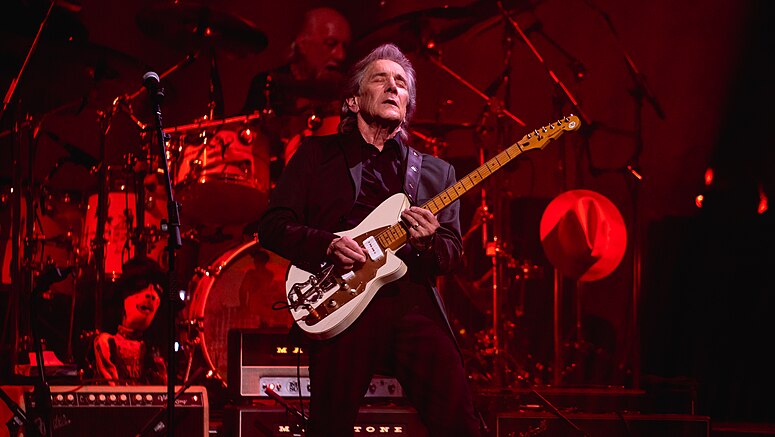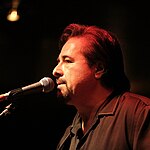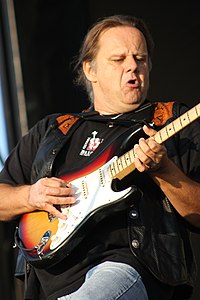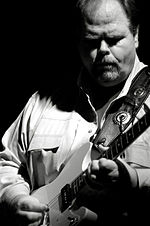List of John Mayall band members
 From Wikipedia - Reading time: 26 min
From Wikipedia - Reading time: 26 min
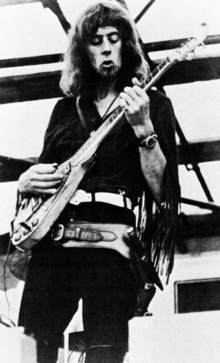
John Mayall was an English blues rock musician. Originally from Macclesfield, he began his career in 1963 when he moved to London and formed John Mayall & the Bluesbreakers. The band's original lineup included Mayall on vocals, keyboards and harmonica, guitarist Bernie Watson, bassist John McVie and drummer Peter Ward. After changing personnel numerous times, the group disbanded in 1968 when Mayall relocated to the United States and continued his career using his own name. The final lineup of Mayall's solo band included bassist Greg Rzab (who first joined in 1999), drummer Jay Davenport (both since 2009) and guitarist Carolyn Wonderland (since 2018).
History
[edit]1963–1968: The Bluesbreakers
[edit]Mayall formed the Bluesbreakers in February 1963. Early performers involved with the band included guitarists Sammy Prosser, Davey Graham and John Gilbey, bassists Ricky Brown and Pete Burford, and drummers Sam Stone, Brian Myall and Keith Robertson. The first official lineup of the group introduced in July included guitarist Bernie Watson, bassist John McVie and drummer Peter Ward.[1] Martin Hart replaced Ward shortly after the band's formation.[2] Shortly before the release of their first single, Watson and Hart were replaced by Roger Dean and Hughie Flint, respectively.[2] A year later, Dean was replaced by Eric Clapton, who debuted with the group on 9 April 1965.[3] By September, the guitarist had abruptly left to form a new band and tour Greece.[4] Several substitutes filled in for Clapton, including John Weider, John Slaughter and Geoff Krivit,[5][6][7] ending with Peter Green for around a week.[8] Clapton returned in November.[9] Meanwhile, McVie had been fired in October and replaced by Jack Bruce, who only stayed for around a month.[9]

Clapton remained until 17 July 1966, after forming Cream the previous day,[10][11] and was replaced again by Green.[12] Flint left the band in September, with Aynsley Dunbar taking his place.[13] The drummer left in April 1967, when he was replaced by Micky Waller and later by Mick Fleetwood.[14][15] Fleetwood was fired after two months, with Green following him to form Fleetwood Mac.[15][14] McVie initially hesitated to join the pair, but did so in September.[14][16] Green was replaced by Mick Taylor and Terry Edmonds, the latter of whom left after only a few weeks.[17] Fleetwood was replaced by Keef Hartley.[18] At the same time, Mayall expanded the group with the addition of saxophonists Chris Mercer and Rip Kant, the latter of whom was replaced by Dick Heckstall-Smith in August.[18] McVie was initially replaced for a month by Paul Williams, and later by Keith Tillman.[18] The group added a seventh member in February 1968, as trumpeter Henry Lowther joined the band.[19]
After the band's first American tour in early 1968, Tillman was replaced for around a month by Andy Fraser. When the bassist joined Free, he was replaced in the Bluesbreakers by Tony Reeves; at the same time, Hartley left and was replaced by Jon Hiseman.[18] This lineup recorded Bare Wires, which was the last studio album to bear the Bluesbreakers name.[20] Soon after the album's release, Reeves, Hiseman and Heckstall-Smith left Mayall's band to form Colosseum, a progressive jazz-rock group.[21] Mercer and Lowther also left, as Mayall disbanded the Bluesbreakers after just a few weeks of touring for Bare Wires.[19] Mayall would subsequently relocate from London to Laurel Canyon, Los Angeles, California in August to continue his career as a solo artist, with Taylor joining him.[18]
1968–1981: Early solo career
[edit]Upon disbanding the Bluesbreakers and moving to the US, Mayall and Taylor recorded Blues from Laurel Canyon with bassist Steve Thompson and drummer Colin Allen.[22] This lineup remained active for almost a year, until Taylor left to replace Brian Jones in The Rolling Stones on 5 June 1969.[23] After the guitarist's departure, Mayall restructured his band to focus on more acoustic music; he replaced Taylor with Jon Mark, dropped Allen from the group, and added saxophonist Johnny Almond.[24] Early the next year, he replaced Thompson with Alex Dmochowski and added Duster Bennett on harmonica.[24] In August, Mark and Almond left to form the eponymous group Mark-Almond,[25] and Mayall put together another lineup which included former Canned Heat members Harvey Mandel (guitar) and Larry Taylor (bass), as well as violinist Don "Sugarcane" Harris.[24] From November 1970 to January 1971, Mayall recorded Back to the Roots with new drummer Paul Lagos and a range of former bandmates.[26]

Following the release of Back to the Roots, Mayall downsized to a lineup of just him, bassist Taylor and new guitarist Jerry McGee, with their only effort Memories released before the end of the year.[27] By the end of the year, the group had been restructured again to reflect a much more jazz-heavy direction, with Mayall enlisting guitarist Freddie Robinson, drummer Ron Selico, saxophonist Clifford Solomon and trumpeter Richard "Blue" Mitchell to record the live album Jazz Blues Fusion.[28] Patrick "Putter" Smith was added as a second bassist in early 1972, before Victor Gaskin took over a few months later.[29][30] Former drummer Hartley returned to replace Selico in June,[31] The group briefly added three more saxophonists – Charles Owens, Fred Jackson and Ernie Watts – for the live album Moving On,[32] before all four were replaced by James "Red" Holloway.[33] This lineup released the album Ten Years Are Gone in September 1973, which marked Mayall's ten-year anniversary as a professional musician.[34]
In early 1974, after recovering from a broken leg, Mayall restructured his band again for a planned European tour, retaining only Holloway and adding guitarist Jesse Ed Davis, returning bassist Larry Taylor and drummer Soko Richardson.[35] Davis was soon replaced by Randy Resnick and Hightide Harris, however.[36] After releasing The Latest Edition, the band's lineup changed again as Mayall, Taylor and Richardson added returning violinist Don "Sugarcane" Harris and new members Rick Vito on guitar, Jay Spell on keyboards and Dee McKinnie on vocals.[37] In 1976, Mayall collaborated with a wide range of his former bandmates for a second time on A Banquet in Blues, released in August.[38] After the album's release, he toured with Taylor, Spell, Holloway, guitarist Gary Rowles and drummer Frank Wilson, plus touring percussionist Warren Bryant, saxophonists Jimmy Roberts, Ann Patterson and David Majal Li, trumpeter Nolan Smith, trombonist Bill Lamb, and vocalist Pepper Watkins.[39]
Mayall downsized again in 1977, bringing back Thompson and Richardson, and adding guitarist James Quill Smith.[40][41] This lineup released A Hard Core Package in 1977 and The Last of the British Blues in 1978.[42][43] After releasing Bottom Line in 1979, an album recorded with various session musicians,[44] Mayall reunited with Mandel, who brought his backing band with him: bassist Angus Thomas, drummer Ruben Alvarez and vocalist Maggie Parker.[45] Mandel pulled out of the tour early on, however, and Smith returned.[45] No More Interviews was released at the end of the year, which also featured former guitarist Vito, keyboardist Chris Cameron and saxophonist Chris Mostert.[46] In 1980, Road Show Blues was recorded with returning drummer Richardson and new bassist Kevin McCormick, as well as Parker and Smith.[47]
1981–2008: The band reforms
[edit]In December 1981, it was announced that John Mayall & the Bluesbreakers would reform for an Australian tour starting the following January, with the frontman joined by guitarist Mick Taylor, bassist John McVie and drummer Colin Allen.[48] Hughie Flint filled in for Allen at four warm-up shows earlier in the month.[48] The tour spawned the live video release Blues Alive,[49] as well as several live tracks for the album Return of the Bluesbreakers.[50] By June, McVie had been replaced by McCormick, who was then replaced by Thompson.[51] In early 1984, Mayall and Taylor toured with bassist Tim Drummond and drummer Mike Gardner.[51][52] Later in the year, Mayall introduced a new lineup of the Bluesbreakers, with Henry "Coco" Montoya and "Kal" David Raskin on guitars, Bobby Haynes on bass and Willie McNeil on drums, who recorded several tracks later released on the album Cross Country Blues.[53] Raskin and McNeil were replaced early the following year by Walter Trout and Joe Yuele, respectively.[54]

The lineup of Montoya, Trout, Haynes and Yuele remained stable for four years, recording two live albums and Mayall's first full studio effort in seven years, Chicago Line.[55][56] In 1989, Trout left the Bluesbreakers to pursue a solo career, releasing his debut album before the end of the year.[57] Rather than replace him, Mayall decided to reduce the band to a four-piece.[58] In 1990, Haynes also left the group.[59] Several tracks on 1990's A Sense of Place were recorded by Daniel "Freebo" Friedberg,[60] who later also replaced Haynes on tour.[58] Rick Cortes took over on bass before the end of the year.[61] Following the release of Wake Up Call in 1993, Montoya left the band to pursue a solo career, with Buddy Whittington taking his place.[62] Cortes left in 1996, with John Paulus taking his place in time to record 1997's Blues for the Lost Days.[63][64]
Greg Rzab replaced Paulus for a European tour in 1999,[65] but left again the following year to join The Black Crowes.[66] Greg Boaz filled in for a tour in the summer of 2000,[67] before Hank Van Sickle took over on a permanent basis in September.[68] Along for the Ride, released in 2001, was credited to "John Mayall & Friends" and featured a wide range of contributors, including current band members, former members and other guest musicians.[69] In early 2001, keyboardist Tom Canning – who had contributed to 1993's Wake Up Call as well as Along for the Ride – was added as an official member of the Bluesbreakers.[70][68] In 2003, Mayall released the live album 70th Birthday Concert, recorded earlier in the year with guests including former members Eric Clapton, Mick Taylor and Henry Lowther.[71]
2008–2024: Later solo work
[edit]In November 2008, Mayall announced that he was retiring the Bluesbreakers name, and would return the following year with a new solo band.[72] By January, he had revealed the members of his eponymous group: lead guitarist Rocky Athas, returning bassist Greg Rzab, and new drummer Jay Davenport.[72][73] This lineup remained unchanged until September 2016, when Athas left Mayall's band due to the frontman's desire to revert to performing as a trio.[74] This format yielded only one album, however – the 2018 live release Three for the Road[75] – before Carolyn Wonderland joined in April 2018 as the band's new lead guitarist.[76] Mayall died in July 2024, ending both the Bluesbreakers and his solo band.[77]
Members
[edit]| Image | Name | Years active | Instruments | Release contributions |
|---|---|---|---|---|
| John Mayall | 1963–2024 (died 2024) |
|
all John Mayall releases | |
| John McVie |
|
bass |
| |
| Bernie Watson | 1963–1964 | lead guitar | "Crawling Up a Hill" (1964) | |
| Peter Ward | 1963 | drums | none | |
| Martin Hart | 1963–1964 | "Crawling Up a Hill" (1964) | ||
| Hughie Flint |
|
| ||
| Roger Dean | 1964–1965 (died 2008) | lead guitar |
| |
| Eric Clapton |
|
|
| |
| John Weider | 1965 | lead guitar | none | |
| John Slaughter | ||||
| Geoff Krivit | 1965 (died 2022) | |||
| Peter Green |
|
|
| |
| Jack Bruce | 1965 (died 2014) | bass |
| |
| Aynsley Dunbar | 1966–1967 | drums |
| |
| Micky Waller | 1967 (died 2008) | none | ||
| Mick Fleetwood | 1967 |
| ||
| Keef Hartley |
|
| ||
| Mick Taylor |
|
lead guitar |
| |
| Terry Edmonds | 1967 | rhythm guitar | none | |
| Chris Mercer | 1967–1968 |
| ||
| Rip Kant | 1967 | baritone saxophone | Crusade (1967) | |
| Dick Heckstall-Smith | 1967–1968 (died 2004) |
|
| |
| Paul Williams | 1967 (died 2019) | bass |
| |
| Keith Tillman | 1967–1968 |
| ||
| Henry Lowther |
|
| ||
| Andy Fraser | 1968 (died 2015) | bass | none | |
| Tony Reeves | 1968 |
|
| |
| Jon Hiseman | 1968 (died 2018) |
| ||
| Steve Thompson |
|
bass |
| |
| Colin Allen |
|
|
| |
| Jon Mark | 1969–1970 (died 2021) | acoustic guitar |
| |
| Johnny Almond | 1969–1970 (died 2009) |
|
| |
| Alex Dmochowski | 1970 | bass | A Banquet in Blues (1976) – guest appearance on one track | |
| Anthony "Duster" Bennett | 1970 (died 1976) | harmonica | none | |
| Larry Taylor |
|
bass |
| |
| Don "Sugarcane" Harris |
|
|
| |
| Harvey Mandel |
|
lead guitar |
| |
| Paul Lagos | 1970–1971 (died 2009) | drums |
| |
| Gerry McGee | 1971 (died 2019) |
|
| |
| Richard "Blue" Mitchell | 1971–1974 (died 1979) |
|
| |
| Freddie Robinson | 1971–1974 (died 2009) | lead guitar |
| |
| Victor Gaskin |
|
|
| |
| Fred Clark | 1971 | tenor saxophone | Ten Years Are Gone – live volume only Rock the Blues Tonight – three tracks only | |
| Clifford Solomon | 1971–1972 (died 2004) |
|
| |
| Ron Selico | 1971–1972 |
|
Jazz Blues Fusion (1972) | |
| Patrick "Putter" Smith | 1972 |
|
none | |
| Ernie Watts | 1972–1974 | tenor saxophone | Moving On (1972) | |
| Charles Owens |
| |||
| Fred Jackson |
| |||
| James "Red" Holloway |
|
|
| |
| Soko Richardson |
|
|
| |
| Jesse Ed Davis | 1974 (died 1988) | lead guitar | none | |
| Randy Resnick | 1974 | The Latest Edition (1974) | ||
| Hightide Harris (Willie Boyd/Willie Gitry) | ||||
| Jay Spell | 1974–1977 (died 2010) |
|
| |
| Rick Vito |
|
|
| |
| Dee McKinnie | 1974–1976 | vocals |
| |
| Pepper Watkins | 1976–1977 | backing vocals |
| |
| Ann Patterson |
|
| ||
| Gary Rowles | lead guitar | Lots of People (1977) | ||
| Frank Wilson | drums | |||
| Warren Bryant | percussion | |||
| Jimmy Roberts | tenor saxophone | |||
| David Majal Li | baritone saxophone | |||
| Nolan Smith | trumpet | |||
| Bill Lamb |
| |||
| James Quill Smith |
|
|
| |
| Maggie Mayall (nee Maggie Parker) |
1979–1981 |
|
| |
| Chris Mostert | 1979–1980 |
|
| |
| Angus Thomas |
|
No More Interviews (1979) | ||
| Rubén Alvarez |
| |||
| Chris Cameron |
| |||
| Kevin McCormick |
|
bass |
| |
| Mike Gardner |
|
drums |
| |
| Don McMinn | 1981 | lead guitar | ||
| Bobby Manuel | rhythm guitar | |||
| Jeff Davis | bass | |||
| Tim Drummond | 1983–1984 (died 2015) | bass |
| |
| Henry "Coco" Montoya | 1984–1993 |
|
| |
| Bobby Haynes Sr. | 1984–1990 (died 2018) | bass |
| |
| "Kal" David Raskin | 1984–1985 | lead guitar |
| |
| Willie McNeil | drums | |||
| Joe Yuele | 1985–2008 |
|
| |
| Walter Trout | 1985–1989 |
|
| |
| Daniel "Freebo" Friedberg | 1990 | bass | A Sense of Place (1990) – three tracks only | |
| Rick Cortes | 1990–1996 |
| ||
| Buddy Whittington | 1993–2008 |
|
| |
| John Paulus | 1996–1999 | bass |
| |
| Greg Rzab |
|
| ||
| Greg Boaz | 2000 | none | ||
| Hank Van Sickle | 2000–2008 |
|
| |
| Tom Canning | 2001–2008 |
|
| |
| Jay Davenport | 2009–2024 |
|
| |
| Rocky Athas | 2009–2016 | lead guitar |
| |
| Carolyn Wonderland | 2018–2024 |
|
Nobody Told Me (2019) |
Timeline
[edit]
Lineups
[edit]| Period | Members | Releases |
|---|---|---|
| July – August 1963 |
|
none |
| August 1963 – April 1964 |
|
|
| April 1964 |
|
none |
| April 1964 – April 1965 |
|
|
| April – September 1965 |
|
|
| September – October 1965 |
|
none |
| ||
| October 1965 |
| |
| ||
| October – November 1965 |
| |
| November 1965 |
| |
| November 1965 – July 1966 |
|
|
| July – September 1966 |
|
none |
| September 1966 – April 1967 |
|
|
| April 1967 |
|
none |
| April – June 1967 |
|
|
| June 1967 |
|
none |
| June 1967 |
| |
| June – August 1967 |
|
|
| August – September 1967 |
|
none |
| September – October 1967 |
|
|
| October 1967 – February 1968 |
|
|
| February – March 1968 |
|
none |
| March – April 1968 |
| |
| April – July 1968 |
|
|
| August 1968 – June 1969 |
|
|
| June 1969 – early 1970 |
|
|
| Early – August 1970 |
|
none |
| August – November 1970 |
|
|
| November 1970 – early 1971 |
|
|
| Early – late 1971 |
|
|
| Late 1971 |
|
|
| November 1971 – March 1972 |
|
|
| March – April 1972 |
|
none |
| April – June 1972 |
| |
| June – July 1972 |
| |
| July 1972 – early 1973 |
|
|
| Early 1973 – early 1974 |
|
|
| March – April 1974 |
|
none |
| May – November 1974 |
|
|
| November 1974 – early 1976 |
|
|
| Early – late 1976 |
|
|
| Late 1976 – early 1977 |
|
|
| 1977–1978 |
|
|
| Early 1979 |
|
none |
| Early – mid-1979 |
| |
| Mid 1979 – early 1980 |
|
|
| 1980–1981 |
|
|
| Mid-1981 |
|
|
| January 1982 |
|
none |
| January – June 1982 |
|
|
| June 1982 – early 1983 |
|
|
| Early – late 1983 |
|
none |
| Late 1983 – mid-1984 |
| |
| Summer 1984 – early 1985 |
|
|
| Early 1985 – mid-1989 |
|
|
| Mid-1989 – early 1990 |
|
|
| Early – late 1990 |
|
none |
| Late 1990 – 1993 |
|
|
| 1993–1996 |
|
|
| 1996–1999 |
|
|
| 1999 – summer 2000 |
|
|
| Summer 2000 |
|
none |
| September 2000 – March 2001 |
| |
| March 2001 – November 2008 |
|
|
| January 2009 – September 2016 |
|
|
| September 2016 – April 2018 |
|
|
| April 2018 – July 2024 |
|
|
Footnotes
[edit]- ^ "Lonely Years" features Mayall and Clapton only, and accordingly is credited to the duo rather than the Bluesbreakers.[78]
- ^ "Curly" features Green, McVie and Dunbar only, and is the only release credited to the Bluesbreakers without Mayall.[79]
- ^ In addition to the band's regular lineup, Back to the Roots also features a number of former band members as guest contributors.[26]
- ^ In addition to the band's regular lineup, A Banquet in Blues also features a number of former band members as guest contributors.[38]
- ^ In addition to the band's regular lineup, Along for the Ride also features a number of former band members and other musicians as guest contributors.[69]
- ^ In addition to the band's regular lineup, 70th Birthday Concert also features a number of former band members as guest contributors.[71]
Bibliography
[edit]- Bowling, David (18 July 2013), Eric Clapton FAQ: All That's Left to Know About Slowhand, Milwaukee, Wisconsin: Backbeat Books, ISBN 978-1617134548
- Brunning, Bob (26 May 1986), Blues: The British Connection, London, England: Blandford Press, ISBN 978-0713718362
- Egan, Sean (1 July 2016), Fleetwood Mac on Fleetwood Mac: Interviews and Encounters, Chicago, Illinois: Chicago Review Press, ISBN 978-1613732342
References
[edit]- ^ "John Mayall's Bluesbreakers: The Last Time" (PDF). Radio & Records. No. 758. Los Angeles, California: Radio & Records, Inc. 7 October 1988. p. 93. Retrieved 18 January 2019.
- ^ a b Bowling 2013, p. 67
- ^ "9 April 1965 – John Mayall's Bluesbreakers". Where's Eric! Magazine. Retrieved 9 January 2019.
- ^ Bowling 2013, p. 69
- ^ Harris, Craig. "Dr. K's Blues Band: Biography & History". AllMusic. Retrieved 9 January 2019.
- ^ Elliott, Bob. "Gig List – 1965–2014". Jack Bruce. Retrieved 9 January 2019.
- ^ gordonskene (3 November 2021). "John Mayall's Bluesbreakers With Eric Clapton - Live On Saturday Club - 1965 - Past Daily Soundbooth". Past Daily: A Sound Archive of News, History, Music. Retrieved 13 May 2024.
- ^ Black, Johnny (28 November 2013). "Fleetwood Mac: "Green's the best blues guitarist the UK's produced"". Blues. Retrieved 9 January 2019.
- ^ a b Bowling 2013, p. 71
- ^ "17 July 1966 – John Mayall's Bluesbreakers". Where's Eric! Magazine. Retrieved 9 January 2019.
- ^ Ortiz, Patrick (15 July 2016). "This Week in Rock History: July 15 – July 21". Joe Bonamassa. Retrieved 9 January 2019.
- ^ Allan, Mark. "Peter Green: Biography & History". AllMusic. Retrieved 9 January 2019.
- ^ Sinclair, David (22 January 2016). "1966 – The Year That Built Rock: The Brit Blues boom". Louder. Retrieved 9 January 2019.
- ^ a b c Egan 2016, pp. 181–182
- ^ a b Bowling 2013, p. 75
- ^ Swanson, Dave (28 December 2014). "Fleetwood Mac Lineup Changes: A Complete Guide". Ultimate Classic Rock. Retrieved 9 January 2019.
- ^ Brunning 1986, p. 52
- ^ a b c d e Knemeyer, George (14 November 1970). "Yardbirds, Mayall, Cream, Bond, Beck, Zeppelin, Faith... Keep on Rolling" (PDF). Billboard. Vol. 82, no. 46. New York City: Billboard Publications, Inc. p. R-40. Retrieved 9 January 2019.
- ^ a b King, Stevie (2016). "History of British Blues: Classic British Blues Albums: "Bare Wires" – John Mayall's Bluesbreakers". UK Blues Federation. Retrieved 9 January 2019.
- ^ Ruhlmann, William. "Bare Wires – John Mayall & the Bluesbreakers, John Mayall: Songs, Reviews, Credits". AllMusic. Retrieved 9 January 2019.
- ^ Deming, Mark. "Colosseum: Biography & History". AllMusic. Retrieved 9 January 2019.
- ^ Davies, Ben. "Blues from Laurel Canyon – John Mayall: Songs, Reviews, Credits". AllMusic. Retrieved 9 January 2019.
- ^ Kelley, Ken (9 June 2015). "The Day Mick Taylor Joined The Rolling Stones". Ultimate Classic Rock. Retrieved 9 January 2019.
- ^ a b c Knemeyer, George (14 November 1970). "Yardbirds, Mayall, Cream, Bond, Beck, Zeppelin, Faith... Keep on Rolling" (PDF). Billboard. Vol. 82, no. 46. New York City: Billboard Publications, Inc. p. R-42. Retrieved 9 January 2019.
- ^ Huey, Steve. "Mark-Almond: Biography & History". AllMusic. Retrieved 9 January 2019.
- ^ a b Ruhlmann, William. "Back to the Roots – John Mayall: Songs, Reviews, Credits". AllMusic. Retrieved 9 January 2019.
- ^ Ruhlmann, William. "Memories – John Mayall: Songs, Reviews, Credits". AllMusic. Retrieved 9 January 2019.
- ^ Brack, Ray (27 November 1971). "Talent in Action: John Mayall, Crazy Horse" (PDF). Billboard. Vol. 83, no. 48. New York City: Billboard Publications, Inc. p. 13. Retrieved 9 January 2019.
- ^ Freedland, Nat (18 March 1972). "From the Music Capitals of the World: Los Angeles" (PDF). Billboard. Vol. 84, no. 12. New York City: Billboard Publications, Inc. p. 23. Retrieved 9 January 2019.
- ^ Mayall, John (2009). Moving On (Back cover). Lemon Recordings. Retrieved 9 January 2019.
- ^ Yorke, Ritchie (1 July 1972). "From the Music Capitals of the World: Barcelona" (PDF). Billboard. Vol. 84, no. 27. New York City: Billboard Publications, Inc. p. 44. Retrieved 9 January 2019.
- ^ "Moving On – John Mayall: Credits". AllMusic. Retrieved 9 January 2019.
- ^ Gelormine, Phil (24 November 1973). "Talent in Action: John Mayall, ZZ Top, Flash Cadillac & the Continental Kids" (PDF). Billboard. Vol. 85, no. 47. New York City: Billboard Publications, Inc. p. 26. Retrieved 9 January 2019.
- ^ "John Mayall – The First Decade" (PDF). Record World. Vol. 29, no. 1371. New York City: Record World Publishing Co., Inc. 29 September 1973. p. 25. Retrieved 9 January 2019.
- ^ "Mayall dates" (PDF). Record & Radio Mirror. London, England: Billboard Publications, Inc. 9 March 1974. p. 4. Retrieved 9 January 2019.
- ^ "Mayall to Play Europe in '74" (PDF). Cash Box. Vol. 25, no. 51. New York City: The Cash Box Publishing Co., Inc. 4 May 1974. p. 42. Retrieved 9 January 2019.
- ^ "Mayall Signs to ABC Records" (PDF). Cash Box. Vol. 36, no. 27. New York City: The Cash Box Publishing Co., Inc. 30 November 1974. pp. 7, 43. Retrieved 9 January 2019.
- ^ a b "Record World Album Picks" (PDF). Record World. Vol. 33, no. 1520. New York City: Record World Publishing Co., Inc. 14 August 1976. p. 16. Retrieved 9 January 2019.
- ^ "Lots of People – John Mayall: Credits". AllMusic. Retrieved 9 January 2019.
- ^ Palmer, Robert (12 July 1977). "Scarlet Rivera And John Mayall Are 'Off Beat'". The New York Times. Retrieved 9 January 2019.
- ^ "Record World Album Picks" (PDF). Record World. Vol. 35, no. 1575. New York City: Record World Publishing Co., Inc. 10 September 1977. p. 16. Retrieved 9 January 2019.
- ^ "A Hard Core Package – John Mayall: Credits". AllMusic. Retrieved 9 January 2019.
- ^ "The Last of the British Blues – John Mayall: Credits". AllMusic. Retrieved 9 January 2019.
- ^ "Bottom Line – John Mayall: Credits". AllMusic. Retrieved 9 January 2019.
- ^ a b Harrison, Victor (7 April 1979). "Talent in Action: John Mayall" (PDF). Billboard. Vol. 91, no. 14. New York City: Billboard Publications, Inc. p. 49. Retrieved 9 January 2019.
- ^ "No More Interviews – John Mayall: Credits". AllMusic. Retrieved 9 January 2019.
- ^ Ruhlmann, William. "Road Show Blues – John Mayall: Songs, Reviews, Credits". AllMusic. Retrieved 9 January 2019.
- ^ a b Baker, Glenn A. (19 December 1981). "Mayall to Tour Australia" (PDF). Billboard. Vol. 93, no. 50. New York City: Billboard Publications, Inc. p. 20. Retrieved 9 January 2019.
- ^ "John Mayall Biography". John Mayall. Retrieved 9 January 2019.
- ^ "Now Available: John Mayall's Bluesbreakers, "Return of the Bluesbreakers"" (PDF). AIM. Retrieved 9 January 2019.
- ^ a b "John Mayall's Bluesbreakers Reunion Tour 1982". Chrome Oxide. Retrieved 9 January 2019.
- ^ Zentgraf, Nico. "Mick Taylor Database 1984". The Complete Works Website. Retrieved 9 January 2019.
- ^ "Cross Country Blues – John Mayall & the Bluesbreakers: Credits". AllMusic. Retrieved 9 January 2019.
- ^ Ruhlmann, William. "Behind the Iron Curtain – John Mayall: Songs, Reviews, Credits". AllMusic. Retrieved 9 January 2019.
- ^ Ruhlmann, William. "Chicago Line – John Mayall & the Bluesbreakers: Songs, Reviews, Credits". AllMusic. Retrieved 9 January 2019.
- ^ "John Mayall Biography". Judy Totton Publicity. Retrieved 9 January 2019.
- ^ Boehm, Mike (23 November 1989). "Rating New Releases of Orange County-Based Musicians". Los Angeles Times. Retrieved 9 January 2019.
- ^ a b Boehm, Mike (26 November 1990). "Pop Music Review: Mayall Provides a Welcome Dose of Authenticity". Los Angeles Times. Retrieved 9 January 2019.
- ^ Kohlhaase, Bill (19 August 1995). "Bassist Haynes in His Element at Spaghettini". Los Angeles Times. Retrieved 9 January 2019.
- ^ Ruhlmann, William. "A Sense of Place – John Mayall & the Bluesbreakers: Songs, Reviews, Credits". AllMusic. Retrieved 9 January 2019.
- ^ Locey, Bill (5 December 1991). "John Mayall's Blues". Los Angeles Times. Retrieved 9 January 2019.
- ^ Appleford, Steve (11 February 1994). "Happy With the Blues". Los Angeles Times. Retrieved 9 January 2019.
- ^ "Blues for the Lost Days – John Mayall & the Bluesbreakers: Credits". AllMusic. Retrieved 9 January 2019.
- ^ Seigal, Buddy (28 June 1997). "No Break From the Blues". Los Angeles Times. Retrieved 9 January 2019.
- ^ "Greg Rzab". Ampeg. Retrieved 9 January 2019.
- ^ Kot, Greg (23 June 2000). "Greg Rzab Gets His Big Break with the Black Crowes". Chicago Tribune. Retrieved 9 January 2019.
- ^ Comerford, Will (28 August 2000). "John Mayall, Bluesbreakers To Tour With Peter Green". MTV. Archived from the original on 14 August 2016. Retrieved 9 January 2019.
- ^ a b "Bluesbreakers Now". John Mayall. Archived from the original on 1 April 2001. Retrieved 9 January 2019.
- ^ a b "Along for the Ride – John Mayall: Credits". AllMusic. Retrieved 9 January 2019.
- ^ Sprague, David (26 April 2001). "John Mayall's Bluesbreakers". Variety. Retrieved 9 January 2019.
- ^ a b Jurek, Thom. "70th Birthday Concert – John Mayall & the Bluesbreakers: Songs, Reviews, Credits". AllMusic. Retrieved 9 January 2019.
- ^ a b Dicker, Jarrod (6 December 2009). "John Mayall: Unbreakable". JamBase. Retrieved 9 January 2019.
- ^ "John Mayall and the New Band". John Mayall. Archived from the original on 25 January 2009. Retrieved 9 January 2019.
- ^ Athas, Rocky (1 September 2016). "Legendary Texas Guitarist Rocky Athas and Blues Icon John Mayall End". Rocky Athas. Retrieved 9 January 2019.
- ^ Gunther, Marty (2 February 2018). "John Mayall – Three for the Road: Album Review". Blues Blast Magazine. Retrieved 9 January 2019.
- ^ Mayall, John (6 April 2018). "John Welcomes Carolyn Wonderland to the Band". John Mayall. Retrieved 9 January 2019.
- ^ Rozzo, Mark (23 July 2024). "Blues Legend John Mayall Is Dead at 90". Vanity Fair. Retrieved 29 July 2024.
- ^ Shapiro, Harry (4 May 2018). "John Mayall's Bluesbreakers with Eric Clapton: The Making of 'the Beano album'..." Blues. Retrieved 9 January 2019.
- ^ Larkin, Colin (27 May 2011). The Encyclopedia of Popular Music. London, England: Omnibus Press. p. 1541. ISBN 978-1846098567. Retrieved 9 January 2019.
 KSF
KSF





